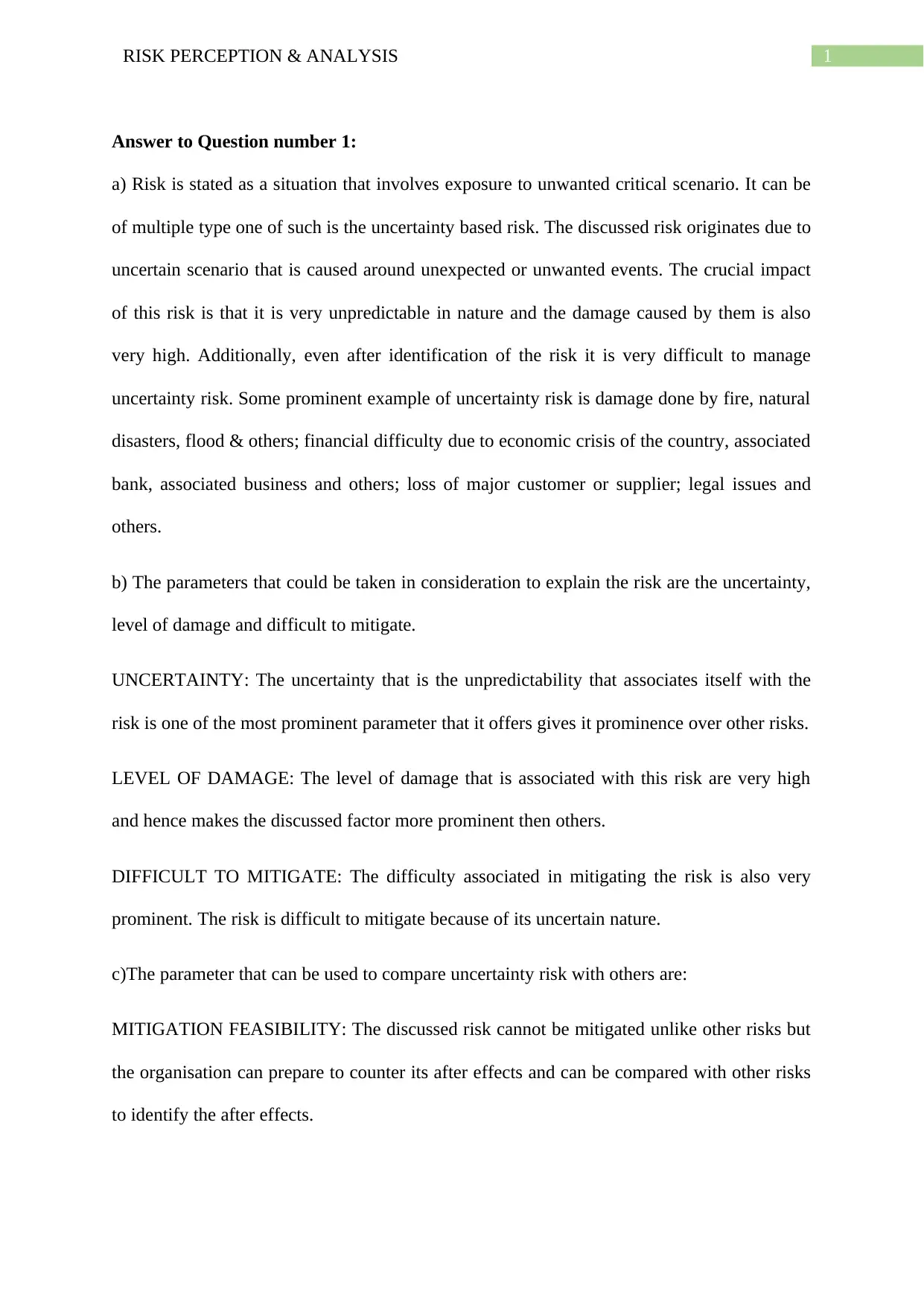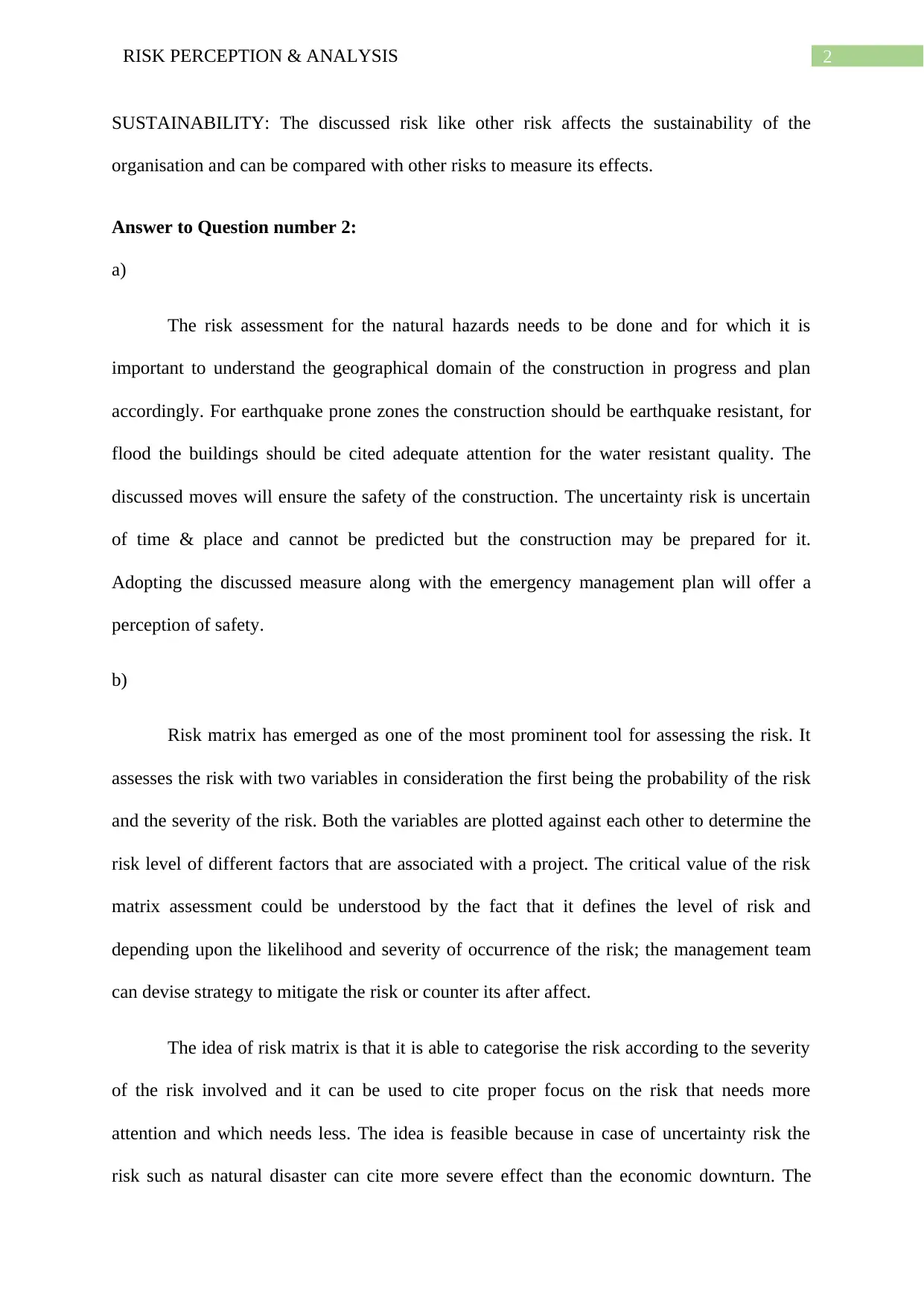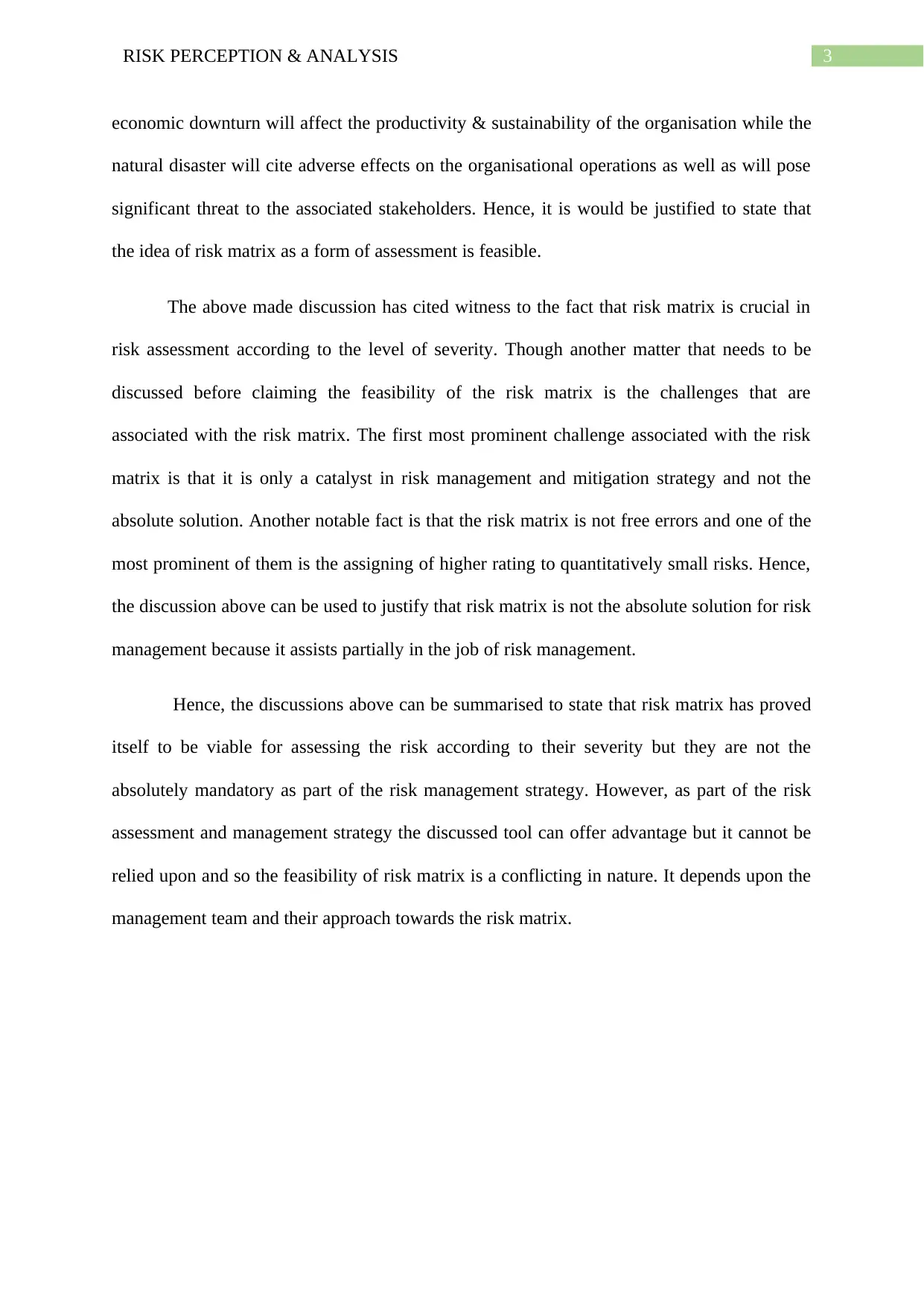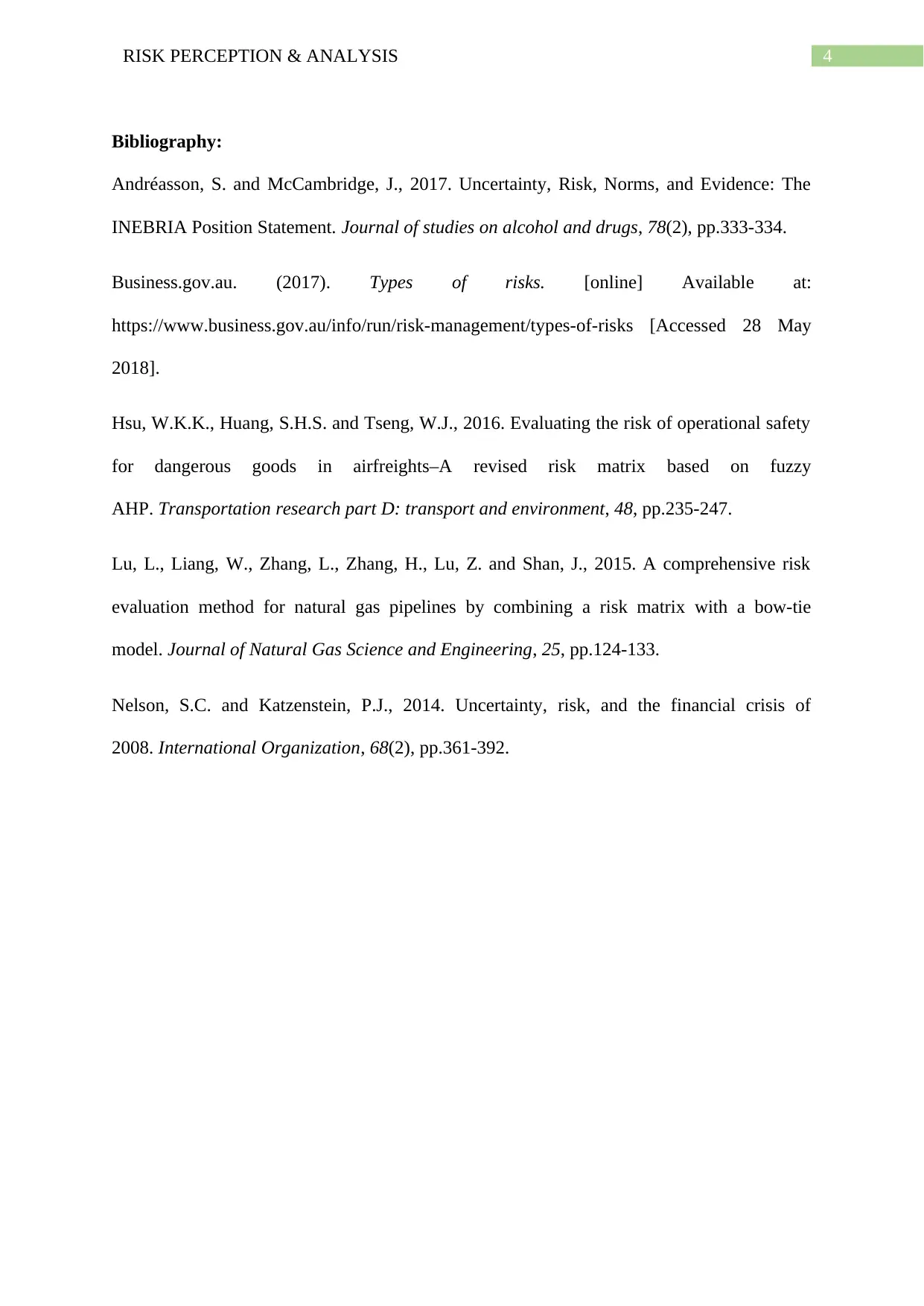RSK80003 Risk Perception and Analysis: Swinburne University
VerifiedAdded on 2023/06/11
|5
|1174
|445
Report
AI Summary
This report provides an analysis of risk perception, focusing on uncertainty-based risks and their unpredictable nature. It discusses parameters for explaining and comparing uncertainty risks, such as mitigation feasibility and sustainability. The report emphasizes the importance of risk assessment for natural hazards, considering geographical domains and construction planning. It evaluates the risk matrix as a tool for assessing risk based on probability and severity, highlighting its strengths and limitations. While the risk matrix is valuable for categorizing risks and prioritizing attention, it is not an absolute solution and requires careful management. The report concludes that the feasibility of the risk matrix depends on the management team's approach, citing its advantages and challenges in risk management.

Running head: RISK PERCEPTION & ANALYSIS
RISK PERCEPTION & ANALYSIS
Name of the Student
Name of the University
Author Note
RISK PERCEPTION & ANALYSIS
Name of the Student
Name of the University
Author Note
Paraphrase This Document
Need a fresh take? Get an instant paraphrase of this document with our AI Paraphraser

1RISK PERCEPTION & ANALYSIS
Answer to Question number 1:
a) Risk is stated as a situation that involves exposure to unwanted critical scenario. It can be
of multiple type one of such is the uncertainty based risk. The discussed risk originates due to
uncertain scenario that is caused around unexpected or unwanted events. The crucial impact
of this risk is that it is very unpredictable in nature and the damage caused by them is also
very high. Additionally, even after identification of the risk it is very difficult to manage
uncertainty risk. Some prominent example of uncertainty risk is damage done by fire, natural
disasters, flood & others; financial difficulty due to economic crisis of the country, associated
bank, associated business and others; loss of major customer or supplier; legal issues and
others.
b) The parameters that could be taken in consideration to explain the risk are the uncertainty,
level of damage and difficult to mitigate.
UNCERTAINTY: The uncertainty that is the unpredictability that associates itself with the
risk is one of the most prominent parameter that it offers gives it prominence over other risks.
LEVEL OF DAMAGE: The level of damage that is associated with this risk are very high
and hence makes the discussed factor more prominent then others.
DIFFICULT TO MITIGATE: The difficulty associated in mitigating the risk is also very
prominent. The risk is difficult to mitigate because of its uncertain nature.
c)The parameter that can be used to compare uncertainty risk with others are:
MITIGATION FEASIBILITY: The discussed risk cannot be mitigated unlike other risks but
the organisation can prepare to counter its after effects and can be compared with other risks
to identify the after effects.
Answer to Question number 1:
a) Risk is stated as a situation that involves exposure to unwanted critical scenario. It can be
of multiple type one of such is the uncertainty based risk. The discussed risk originates due to
uncertain scenario that is caused around unexpected or unwanted events. The crucial impact
of this risk is that it is very unpredictable in nature and the damage caused by them is also
very high. Additionally, even after identification of the risk it is very difficult to manage
uncertainty risk. Some prominent example of uncertainty risk is damage done by fire, natural
disasters, flood & others; financial difficulty due to economic crisis of the country, associated
bank, associated business and others; loss of major customer or supplier; legal issues and
others.
b) The parameters that could be taken in consideration to explain the risk are the uncertainty,
level of damage and difficult to mitigate.
UNCERTAINTY: The uncertainty that is the unpredictability that associates itself with the
risk is one of the most prominent parameter that it offers gives it prominence over other risks.
LEVEL OF DAMAGE: The level of damage that is associated with this risk are very high
and hence makes the discussed factor more prominent then others.
DIFFICULT TO MITIGATE: The difficulty associated in mitigating the risk is also very
prominent. The risk is difficult to mitigate because of its uncertain nature.
c)The parameter that can be used to compare uncertainty risk with others are:
MITIGATION FEASIBILITY: The discussed risk cannot be mitigated unlike other risks but
the organisation can prepare to counter its after effects and can be compared with other risks
to identify the after effects.

2RISK PERCEPTION & ANALYSIS
SUSTAINABILITY: The discussed risk like other risk affects the sustainability of the
organisation and can be compared with other risks to measure its effects.
Answer to Question number 2:
a)
The risk assessment for the natural hazards needs to be done and for which it is
important to understand the geographical domain of the construction in progress and plan
accordingly. For earthquake prone zones the construction should be earthquake resistant, for
flood the buildings should be cited adequate attention for the water resistant quality. The
discussed moves will ensure the safety of the construction. The uncertainty risk is uncertain
of time & place and cannot be predicted but the construction may be prepared for it.
Adopting the discussed measure along with the emergency management plan will offer a
perception of safety.
b)
Risk matrix has emerged as one of the most prominent tool for assessing the risk. It
assesses the risk with two variables in consideration the first being the probability of the risk
and the severity of the risk. Both the variables are plotted against each other to determine the
risk level of different factors that are associated with a project. The critical value of the risk
matrix assessment could be understood by the fact that it defines the level of risk and
depending upon the likelihood and severity of occurrence of the risk; the management team
can devise strategy to mitigate the risk or counter its after affect.
The idea of risk matrix is that it is able to categorise the risk according to the severity
of the risk involved and it can be used to cite proper focus on the risk that needs more
attention and which needs less. The idea is feasible because in case of uncertainty risk the
risk such as natural disaster can cite more severe effect than the economic downturn. The
SUSTAINABILITY: The discussed risk like other risk affects the sustainability of the
organisation and can be compared with other risks to measure its effects.
Answer to Question number 2:
a)
The risk assessment for the natural hazards needs to be done and for which it is
important to understand the geographical domain of the construction in progress and plan
accordingly. For earthquake prone zones the construction should be earthquake resistant, for
flood the buildings should be cited adequate attention for the water resistant quality. The
discussed moves will ensure the safety of the construction. The uncertainty risk is uncertain
of time & place and cannot be predicted but the construction may be prepared for it.
Adopting the discussed measure along with the emergency management plan will offer a
perception of safety.
b)
Risk matrix has emerged as one of the most prominent tool for assessing the risk. It
assesses the risk with two variables in consideration the first being the probability of the risk
and the severity of the risk. Both the variables are plotted against each other to determine the
risk level of different factors that are associated with a project. The critical value of the risk
matrix assessment could be understood by the fact that it defines the level of risk and
depending upon the likelihood and severity of occurrence of the risk; the management team
can devise strategy to mitigate the risk or counter its after affect.
The idea of risk matrix is that it is able to categorise the risk according to the severity
of the risk involved and it can be used to cite proper focus on the risk that needs more
attention and which needs less. The idea is feasible because in case of uncertainty risk the
risk such as natural disaster can cite more severe effect than the economic downturn. The
⊘ This is a preview!⊘
Do you want full access?
Subscribe today to unlock all pages.

Trusted by 1+ million students worldwide

3RISK PERCEPTION & ANALYSIS
economic downturn will affect the productivity & sustainability of the organisation while the
natural disaster will cite adverse effects on the organisational operations as well as will pose
significant threat to the associated stakeholders. Hence, it is would be justified to state that
the idea of risk matrix as a form of assessment is feasible.
The above made discussion has cited witness to the fact that risk matrix is crucial in
risk assessment according to the level of severity. Though another matter that needs to be
discussed before claiming the feasibility of the risk matrix is the challenges that are
associated with the risk matrix. The first most prominent challenge associated with the risk
matrix is that it is only a catalyst in risk management and mitigation strategy and not the
absolute solution. Another notable fact is that the risk matrix is not free errors and one of the
most prominent of them is the assigning of higher rating to quantitatively small risks. Hence,
the discussion above can be used to justify that risk matrix is not the absolute solution for risk
management because it assists partially in the job of risk management.
Hence, the discussions above can be summarised to state that risk matrix has proved
itself to be viable for assessing the risk according to their severity but they are not the
absolutely mandatory as part of the risk management strategy. However, as part of the risk
assessment and management strategy the discussed tool can offer advantage but it cannot be
relied upon and so the feasibility of risk matrix is a conflicting in nature. It depends upon the
management team and their approach towards the risk matrix.
economic downturn will affect the productivity & sustainability of the organisation while the
natural disaster will cite adverse effects on the organisational operations as well as will pose
significant threat to the associated stakeholders. Hence, it is would be justified to state that
the idea of risk matrix as a form of assessment is feasible.
The above made discussion has cited witness to the fact that risk matrix is crucial in
risk assessment according to the level of severity. Though another matter that needs to be
discussed before claiming the feasibility of the risk matrix is the challenges that are
associated with the risk matrix. The first most prominent challenge associated with the risk
matrix is that it is only a catalyst in risk management and mitigation strategy and not the
absolute solution. Another notable fact is that the risk matrix is not free errors and one of the
most prominent of them is the assigning of higher rating to quantitatively small risks. Hence,
the discussion above can be used to justify that risk matrix is not the absolute solution for risk
management because it assists partially in the job of risk management.
Hence, the discussions above can be summarised to state that risk matrix has proved
itself to be viable for assessing the risk according to their severity but they are not the
absolutely mandatory as part of the risk management strategy. However, as part of the risk
assessment and management strategy the discussed tool can offer advantage but it cannot be
relied upon and so the feasibility of risk matrix is a conflicting in nature. It depends upon the
management team and their approach towards the risk matrix.
Paraphrase This Document
Need a fresh take? Get an instant paraphrase of this document with our AI Paraphraser

4RISK PERCEPTION & ANALYSIS
Bibliography:
Andréasson, S. and McCambridge, J., 2017. Uncertainty, Risk, Norms, and Evidence: The
INEBRIA Position Statement. Journal of studies on alcohol and drugs, 78(2), pp.333-334.
Business.gov.au. (2017). Types of risks. [online] Available at:
https://www.business.gov.au/info/run/risk-management/types-of-risks [Accessed 28 May
2018].
Hsu, W.K.K., Huang, S.H.S. and Tseng, W.J., 2016. Evaluating the risk of operational safety
for dangerous goods in airfreights–A revised risk matrix based on fuzzy
AHP. Transportation research part D: transport and environment, 48, pp.235-247.
Lu, L., Liang, W., Zhang, L., Zhang, H., Lu, Z. and Shan, J., 2015. A comprehensive risk
evaluation method for natural gas pipelines by combining a risk matrix with a bow-tie
model. Journal of Natural Gas Science and Engineering, 25, pp.124-133.
Nelson, S.C. and Katzenstein, P.J., 2014. Uncertainty, risk, and the financial crisis of
2008. International Organization, 68(2), pp.361-392.
Bibliography:
Andréasson, S. and McCambridge, J., 2017. Uncertainty, Risk, Norms, and Evidence: The
INEBRIA Position Statement. Journal of studies on alcohol and drugs, 78(2), pp.333-334.
Business.gov.au. (2017). Types of risks. [online] Available at:
https://www.business.gov.au/info/run/risk-management/types-of-risks [Accessed 28 May
2018].
Hsu, W.K.K., Huang, S.H.S. and Tseng, W.J., 2016. Evaluating the risk of operational safety
for dangerous goods in airfreights–A revised risk matrix based on fuzzy
AHP. Transportation research part D: transport and environment, 48, pp.235-247.
Lu, L., Liang, W., Zhang, L., Zhang, H., Lu, Z. and Shan, J., 2015. A comprehensive risk
evaluation method for natural gas pipelines by combining a risk matrix with a bow-tie
model. Journal of Natural Gas Science and Engineering, 25, pp.124-133.
Nelson, S.C. and Katzenstein, P.J., 2014. Uncertainty, risk, and the financial crisis of
2008. International Organization, 68(2), pp.361-392.
1 out of 5
Your All-in-One AI-Powered Toolkit for Academic Success.
+13062052269
info@desklib.com
Available 24*7 on WhatsApp / Email
![[object Object]](/_next/static/media/star-bottom.7253800d.svg)
Unlock your academic potential
Copyright © 2020–2025 A2Z Services. All Rights Reserved. Developed and managed by ZUCOL.